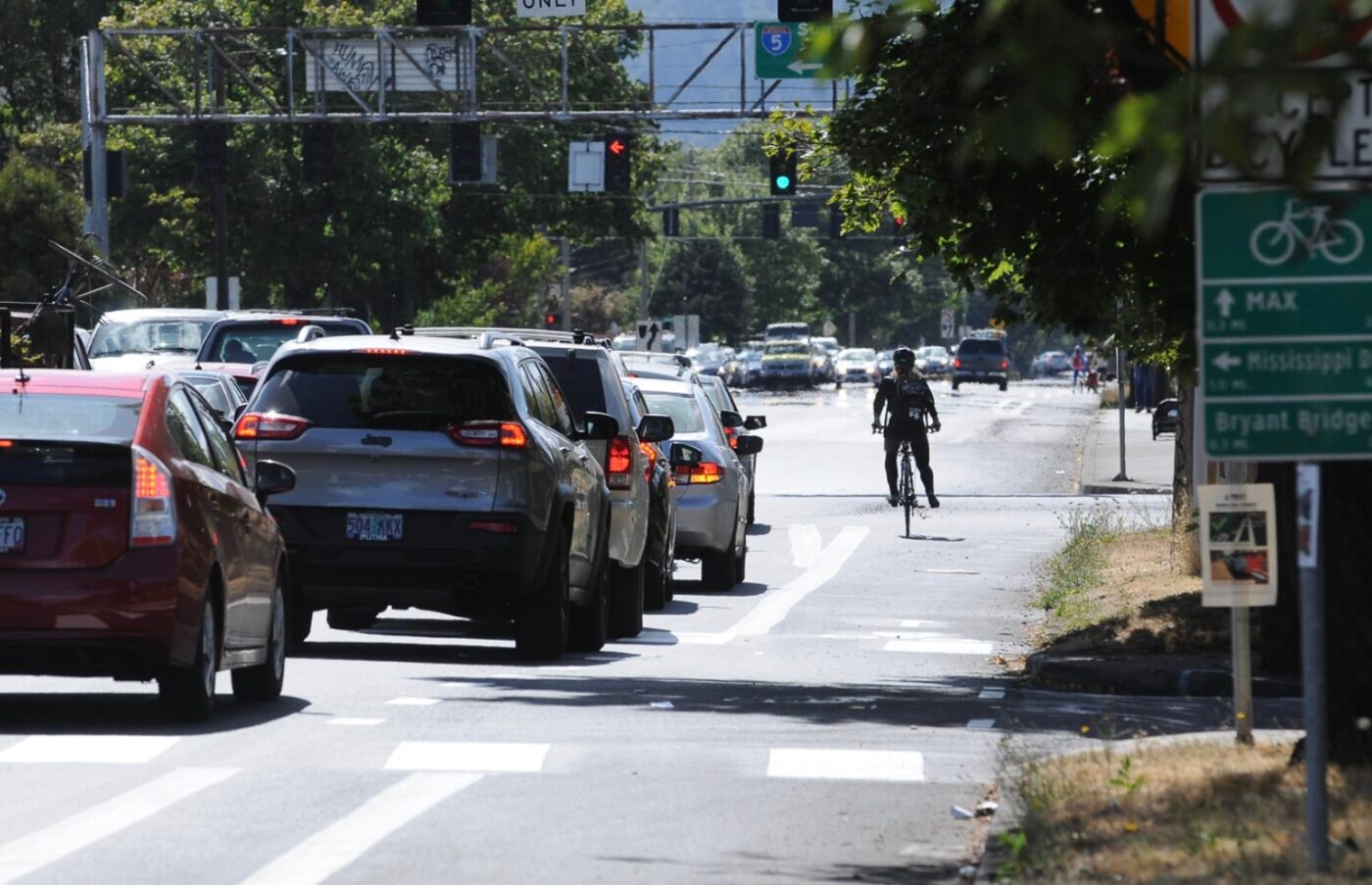Written by Portland resident and road safety activist Sarah Risser. You might recall Risser from her work on ghost bike installations or from a recent episode of our podcast. This essay was submitted as part of a community project to keep BikePortland going while BikePortland Editor & Publisher Jonathan Maus is tending to a family medical emergency out of town and unable to work as normal.
It is objectively and indisputably true that people who choose to walk, cycle, scooter, skateboard or negotiate urban roads in a wheelchair are vulnerable to being killed or injured by vehicular traffic. Portland’s roads are dominated by vehicles that are often driven too fast and embody more kinetic energy than any other mode aside from public transit. In Portland, sidewalks and many bike lanes — if they exist at all — merely separate users from vehicles without offering actual protection in the form of physical barriers. In a distracted or angry heartbeat, a driver could veer off the road and onto a sidewalk or bike lane, and the result would be grim. Feeling vulnerable makes traveling outside of a vehicle stressful and less enjoyable at times.
Leaders and advocates should continue to protect the most vulnerable road users with smart infrastructure investments, but they should think equally or more about reducing the danger itself.
But let’s be clear; it’s not the simple act of walking, biking, or otherwise rolling that evokes feelings of vulnerability. I feel powerful and particularly alive when I’m hiking to Angel’s Rest. And walking along the beach at Nehalem Bay or strolling through fields of spring wildflowers at Catherine Creek is peaceful and grounding. Cycling on the Springwater Corridor elicits a deep and pure sense of happiness. Feelings of vulnerability only arise in the presence of danger; there cannot be vulnerable road users (VRUs) without the presence of vehicular traffic. This may seem obvious, but it begs the question: why, when our roads are dominated by vehicles heavy and powerful enough to kill, do we use language that centers attention on the vulnerability of some road users rather than on the danger that threatens all road users?
To be honest, writing this guest article also makes me feel vulnerable. BikePortland readers are smart and involved and I’m pretty sure some will disagree with my take, because the phrase ‘Vulnerable Road User’ is in such widespread use, and it’s accurate even if it’s not very helpful. Also, I think this is a little nerdy compared to all the other guest articles Jonathan’s printed of people biking to fun places and living car-free lives and doing cool things. I hope you’ll hang in there with me.
The widespread use of ‘vulnerable road user’ by road-safety advocates and transportation professionals alike (and yes, I realize the phrase comes from the legal concept of the same name), draws attention to the symptom — that people’s safety is being continually threatened — of our unacceptably dangerous transportation system. This distracts us from focusing on the root cause of our road safety crisis and implies that living with exceedingly high levels of danger on our roads is locked in, something that we are resigned to tolerate forever. This, in turn, prompts leaders, planners, and safety advocates to call for resources to be directed toward managing the symptom at the expense of directly addressing the cause — the real danger — by reducing speed limits, restricting cars access where appropriate, aggressively incentivizing getting cars off the road etc. In no other realm of public life do we tolerate the levels of danger and violence that we see on our roads.
Of less importance and at the risk of being pedantic, the implication that some road users are “vulnerable”, and others are not, diminishes the scope of danger posed by vehicular traffic, which is huge. While being inside of a car makes a person less vulnerable than traveling outside of a vehicle, people inside of vehicles are killed by the tens of thousands in the US every year. In Portland the number of pedestrians killed and the number of people inside of vehicles killed, year to date, is the same. So, while travelling in a Mini Cooper is arguably safer than walking, because the car serves as a shield or armor for its occupants, there is no guarantee that the Mini won’t be hit head on by a Ford F350. This type of thing happens every day. The danger on our roads is so unacceptably high that every road user, to varying degrees, is at risk of death or injury. Every road user is literally vulnerable.
As Dutch traffic safety researcher Marco te Bormmellstroet pointed out in Increase Road Safety or Reduce Road Danger(Traffic Safety Research, March 5, 2024) leaders and advocates should continue to protect the most vulnerable road users with smart infrastructure investments, but they should think equally or more about reducing the danger itself.
When our use of language directs disproportionate focus on potential victims and shies away from calling out ‘Dangerous Road Users’ or ‘Potentially Lethal Vehicles’ we normalize road violence. We’d be more effective if we intentionally used language that centered and called out the danger itself. Let’s continue to demand safe infrastructure for the most vulnerable road users while talking ever louder and more intentionally about reducing the danger that makes them vulnerable. Let’s make it abundantly clear that the level of danger on our roads is unacceptable and that is our most important problem. Without a looming, ever-present, threat of danger there can be no vulnerability.
— Sarah Risser. Follow her on X at @Henryz_mom.



